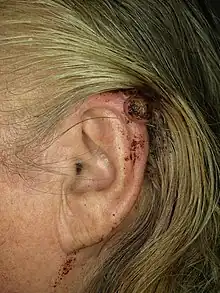Polypoid melanoma
Polypoid melanoma is a rare cutaneous condition, a virulent variant of nodular melanoma.[1]: 696 Polypoid melanoma is a subtype of nodular melanoma, the most aggressive form of melanoma (a skin cancer).[2]
| Polypoid melanoma | |
|---|---|
 | |
| Polypoid melanoma of the left ear in 83-year old woman. | |
| Specialty | Dermatology/Oncology |
Signs and symptoms
Polypoid melanoma is distinguished by a profile that resembles cauliflower and an uneven surface.[3]
Treatment
Therapies for metastatic melanoma include the biological immunotherapy agents ipilimumab, pembrolizumab, and nivolumab; BRAF inhibitors, such as vemurafenib and dabrafenib; and an MEK inhibitor trametinib.[4]
See also
References
- James, William D.; Berger, Timothy G.; et al. (2006). Andrews' Diseases of the Skin: clinical Dermatology. Saunders Elsevier. ISBN 978-0-7216-2921-6.
- Maury, Mikalah E; Jukic, Drazen M (October 13, 2023). "A Case Presentation of Three Polypoid Melanomas With Divergent Features". Cureus. 15 (10). Springer Science and Business Media LLC: e46951. doi:10.7759/cureus.46951. ISSN 2168-8184. PMC 10640706. PMID 38022238.
- Di Altobrando, Ambra; Patrizi, Annalisa; Dika, Emi; Savoia, Francesco (2020). "Cauliflower-like exophytic mass on the skin: polypoid melanoma. Clinical, dermoscopic, and histologic features". Anais Brasileiros de Dermatologia. 95 (6). Elsevier BV: 748–750. doi:10.1016/j.abd.2020.04.010. ISSN 0365-0596. PMC 7672400. PMID 33041156.
- Maverakis E, Cornelius LA, Bowen GM, Phan T, Patel FB, Fitzmaurice S, He Y, Burrall B, Duong C, Kloxin AM, Sultani H, Wilken R, Martinez SR, Patel F (2015). "Metastatic melanoma — a review of current and future treatment options". Acta Derm Venereol. 95 (5): 516–524. doi:10.2340/00015555-2035. PMID 25520039.
Further reading
- Hikawa, Renato Shintani; Kanehisa, Eliza Sayuri; Enokihara, Mílvia Maria Simões e Silva; Enokihara, Mauro Yoshiaki; Hirata, Sérgio Henrique (2014). "Polypoid melanoma and superficial spreading melanoma different subtypes in the same lesion". Anais Brasileiros de Dermatologia. 89 (4). FapUNIFESP (SciELO): 666–668. doi:10.1590/abd1806-4841.20142802. ISSN 0365-0596. PMC 4148288. PMID 25054761.
- Manci, Elizabeth A.; Balch, Charles M.; Murad, Tariq M.; Seng/Jaw, Soong (June 1, 1981). "Polypoid Melanoma, A Virulent Variant of the Nodular Growth Pattern". American Journal of Clinical Pathology. 75 (6). Oxford University Press (OUP): 810–815. doi:10.1093/ajcp/75.6.810. ISSN 0002-9173. PMID 7258141.
External links
This article is issued from Wikipedia. The text is licensed under Creative Commons - Attribution - Sharealike. Additional terms may apply for the media files.